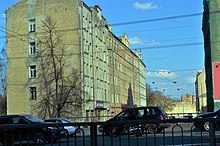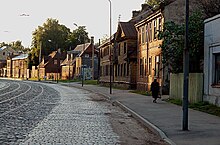Maskavas forštate

Maskavas forštate ( German : Moscow suburb ) is a district of the Latvian capital Riga . It is also called Maskavas priekšpilsēta or colloquially Maskačka .
Located just south of downtown in the district of Latgale priekšpilsēta on the banks of the Daugava . 32,157 inhabitants (2008) live on 749 hectares. The district takes its name from the former highway to Moscow , the Moscow Street ( Maskavas iela ), and is traditionally mainly inhabited by Russians . A large number of "old believers" Russians came as early as the second half of the 17th century when the split in the Russian Orthodox Church broke out in Russia. Under Stalin, the Moscow suburb was expanded into an industrial and working-class district and populated predominantly with Soviet citizens from Russia and Belarus, who also shaped the district in the period after the restoration of Latvian independence, although some of them did not receive Latvian citizenship .
In the district there were considerable problems with the preservation of the historical building fabric. The wooden houses from the Tsarist era also located in the Moscow suburb are part of the UNESCO World Heritage. This protects them and must not be torn off.
The Riga Ghetto was located here during World War II .
The Palace of Culture and Science ( Zinātņu akadēmijas augstceltne ), the Riga Central Market , the Red Warehouses , the wooden Protestant Church of Jesus ( Jēzus Evaņģēliski luteriskā baznīca ) and the ruins of a synagogue are located in Maskavas forštate. The Riga night market also takes place in the district.
Web links
- City administration information (Latvian)
Coordinates: 56 ° 56 ' N , 24 ° 9' E



